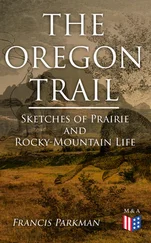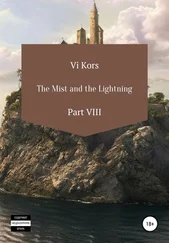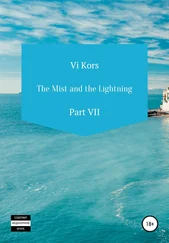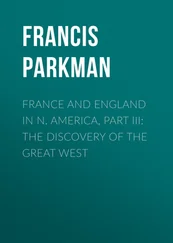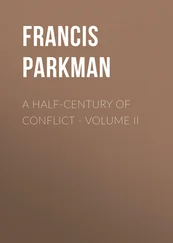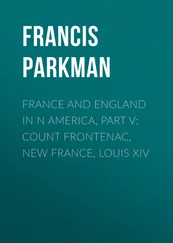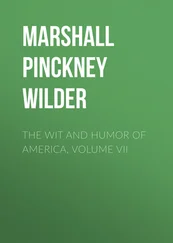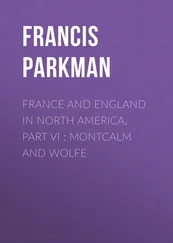Francis Parkman - France and England in N America, Part VII, Vol 1 - A Half-Century of Conflict
Здесь есть возможность читать онлайн «Francis Parkman - France and England in N America, Part VII, Vol 1 - A Half-Century of Conflict» — ознакомительный отрывок электронной книги совершенно бесплатно, а после прочтения отрывка купить полную версию. В некоторых случаях можно слушать аудио, скачать через торрент в формате fb2 и присутствует краткое содержание. Жанр: foreign_prose, История, foreign_edu, foreign_antique, на английском языке. Описание произведения, (предисловие) а так же отзывы посетителей доступны на портале библиотеки ЛибКат.
- Название:France and England in N America, Part VII, Vol 1: A Half-Century of Conflict
- Автор:
- Жанр:
- Год:неизвестен
- ISBN:нет данных
- Рейтинг книги:3 / 5. Голосов: 1
-
Избранное:Добавить в избранное
- Отзывы:
-
Ваша оценка:
- 60
- 1
- 2
- 3
- 4
- 5
France and England in N America, Part VII, Vol 1: A Half-Century of Conflict: краткое содержание, описание и аннотация
Предлагаем к чтению аннотацию, описание, краткое содержание или предисловие (зависит от того, что написал сам автор книги «France and England in N America, Part VII, Vol 1: A Half-Century of Conflict»). Если вы не нашли необходимую информацию о книге — напишите в комментариях, мы постараемся отыскать её.
France and England in N America, Part VII, Vol 1: A Half-Century of Conflict — читать онлайн ознакомительный отрывок
Ниже представлен текст книги, разбитый по страницам. Система сохранения места последней прочитанной страницы, позволяет с удобством читать онлайн бесплатно книгу «France and England in N America, Part VII, Vol 1: A Half-Century of Conflict», без необходимости каждый раз заново искать на чём Вы остановились. Поставьте закладку, и сможете в любой момент перейти на страницу, на которой закончили чтение.
Интервал:
Закладка:
Such was the beginning of Queen Anne's War. These attacks were due less to the Abenakis than to the French who set them on. "Monsieur de Vaudreuil," writes the Jesuit historian Charlevoix, "formed a party of these savages, to whom he joined some Frenchmen under the direction of the Sieur de Beaubassin, when they effected some ravages of no great consequence; they killed, however, about three hundred men." This last statement is doubly incorrect. The whole number of persons killed and carried off during the August attacks did not much exceed one hundred and sixty; 48 48 The careful and well-informed Belknap puts it at only 130. History of New Hampshire , i. 331.
and these were of both sexes and all ages, from octogenarians to newborn infants. The able-bodied men among them were few, as most of the attacks were made upon unprotected houses in the absence of the head of the family; and the only fortified place captured was the garrison-house at Winter Harbor, which surrendered on terms of capitulation. The instruments of this ignoble warfare and the revolting atrocities that accompanied it were all, or nearly all, converted Indians of the missions. Charlevoix has no word of disapproval for it, and seems to regard its partial success as a gratifying one so far as it went.
One of the objects was, no doubt, to check the progress of the English settlements; but, pursues Charlevoix, "the essential point was to commit the Abenakis in such a manner that they could not draw back." 49 49 Charlevoix, ii. 289, 290 (quarto edition).
This object was constantly kept in view. The French claimed at this time that the territory of Acadia reached as far westward as the Kennebec, which therefore formed, in their view, the boundary between the rival nations, and they trusted in the Abenakis to defend this assumed line of demarcation. But the Abenakis sorely needed English guns, knives, hatchets, and kettles, and nothing but the utmost vigilance could prevent them from coming to terms with those who could supply their necessities. Hence the policy of the French authorities on the frontier of New England was the opposite of their policy on the frontier of New York. They left the latter undisturbed, lest by attacking the Dutch and English settlers they should stir up the Five Nations to attack Canada; while, on the other hand, they constantly spurred the Abenakis against New England, in order to avert the dreaded event of their making peace with her.
The attack on Wells, Casco, and the intervening settlements was followed by murders and depredations that lasted through the autumn and extended along two hundred miles of frontier. Thirty Indians attacked the village of Hampton, killed the Widow Mussey, a famous Quakeress, and then fled to escape pursuit. At Black Point nineteen men going to their work in the meadows were ambushed by two hundred Indians, and all but one were shot or captured. The fort was next attacked. It was garrisoned by eight men under Lieutenant Wyatt, who stood their ground for some time, and then escaped by means of a sloop in the harbor. At York the wife and children of Arthur Brandon were killed, and the Widow Parsons and her daughter carried off. At Berwick the Indians attacked the fortified house of Andrew Neal, but were repulsed with the loss of nine killed and many wounded, for which they revenged themselves by burning alive Joseph Ring, a prisoner whom they had taken. Early in February a small party of them hovered about the fortified house of Joseph Bradley at Haverhill, till, seeing the gate open and nobody on the watch, they rushed in. The woman of the house was boiling soap, and in her desperation she snatched up the kettle and threw the contents over them with such effect that one of them, it is said, was scalded to death. The man who should have been on the watch was killed, and several persons were captured, including the woman. It was the second time that she had been a prisoner in Indian hands. Half starved and bearing a heavy load, she followed her captors in their hasty retreat towards Canada. After a time she was safely delivered of an infant in the midst of the winter forest; but the child pined for want of sustenance, and the Indians hastened its death by throwing hot coals into its mouth when it cried. The astonishing vitality of the woman carried her to the end of the frightful journey. A Frenchman bought her from the Indians, and she was finally ransomed by her husband.
By far the most dangerous and harassing attacks were those of small parties skulking under the edge of the forest, or lying hidden for days together, watching their opportunity to murder unawares, and vanishing when they had done so. Against such an enemy there was no defence. The Massachusetts government sent a troop of horse to Portsmouth, and another to Wells. These had the advantage of rapid movement in case of alarm along the roads and forest-paths from settlement to settlement; but once in the woods, their horses were worse than useless, and they could only fight on foot. Fighting, however, was rarely possible; for on reaching the scene of action they found nothing but mangled corpses and burning houses.
The best defence was to take the offensive. In September Governor Dudley sent three hundred and sixty men to the upper Saco, the haunt of the Pequawket tribe; but the place was deserted. Major, now Colonel, March soon after repeated the attempt, killing six Indians, and capturing as many more. The General Court offered £40 for every Indian scalp, and one Captain Tyng, in consequence, surprised an Indian village in midwinter and brought back five of these disgusting trophies. In the spring of 1704 word came from Albany that a band of French Indians had built a fort and planted corn at Coos meadows, high up the river Connecticut. On this, one Caleb Lyman with five friendly Indians, probably Mohegans, set out from Northampton, and after a long march through the forest, surprised, under cover of a thunderstorm, a wigwam containing nine warriors,—bound, no doubt, against the frontier. They killed seven of them; and this was all that was done at present in the way of reprisal or prevention. 50 50 Penhallow, Wars of New England with the Eastern Indians .
The murders and burnings along the borders were destined to continue with little variety and little interruption during ten years. It was a repetition of what the pedantic Cotton Mather calls Decennium luctuosum , or the "woful decade" of William and Mary's War. The wonder is that the outlying settlements were not abandoned. These ghastly, insidious, and ever-present dangers demanded a more obstinate courage than the hottest battle in the open field.
One curious frontier incident may be mentioned here, though it did not happen till towards the end of the war. In spite of poverty, danger, and tribulation, marrying and giving in marriage did not cease among the sturdy borderers; and on a day in September there was a notable wedding feast at the palisaded house of John Wheelwright, one of the chief men of Wells. Elisha Plaisted was to espouse Wheelwright's daughter Hannah, and many guests were assembled, some from Portsmouth, and even beyond it. Probably most of them came in sailboats; for the way by land was full of peril, especially on the road from York, which ran through dense woods, where Indians often waylaid the traveller. The bridegroom's father was present with the rest. It was a concourse of men in homespun, and women and girls in such improvised finery as their poor resources could supply; possibly, in default of better, some wore nightgowns, more or less disguised, over their daily dress, as happened on similar occasions half a century later among the frontiersmen of West Virginia. 51 51 Doddridge, Notes on Western Virginia and Pennsylvania .
After an evening of rough merriment and gymnastic dancing, the guests lay down to sleep under the roof of their host or in adjacent barns and sheds. When morning came, and they were preparing to depart, it was found that two horses were missing; and not doubting that they had strayed away, three young men—Sergeant Tucker, Joshua Downing, and Isaac Cole—went to find them. In a few minutes several gunshots were heard. The three young men did not return. Downing and Cole were killed, and Tucker was wounded and made prisoner.
Интервал:
Закладка:
Похожие книги на «France and England in N America, Part VII, Vol 1: A Half-Century of Conflict»
Представляем Вашему вниманию похожие книги на «France and England in N America, Part VII, Vol 1: A Half-Century of Conflict» списком для выбора. Мы отобрали схожую по названию и смыслу литературу в надежде предоставить читателям больше вариантов отыскать новые, интересные, ещё непрочитанные произведения.
Обсуждение, отзывы о книге «France and England in N America, Part VII, Vol 1: A Half-Century of Conflict» и просто собственные мнения читателей. Оставьте ваши комментарии, напишите, что Вы думаете о произведении, его смысле или главных героях. Укажите что конкретно понравилось, а что нет, и почему Вы так считаете.


